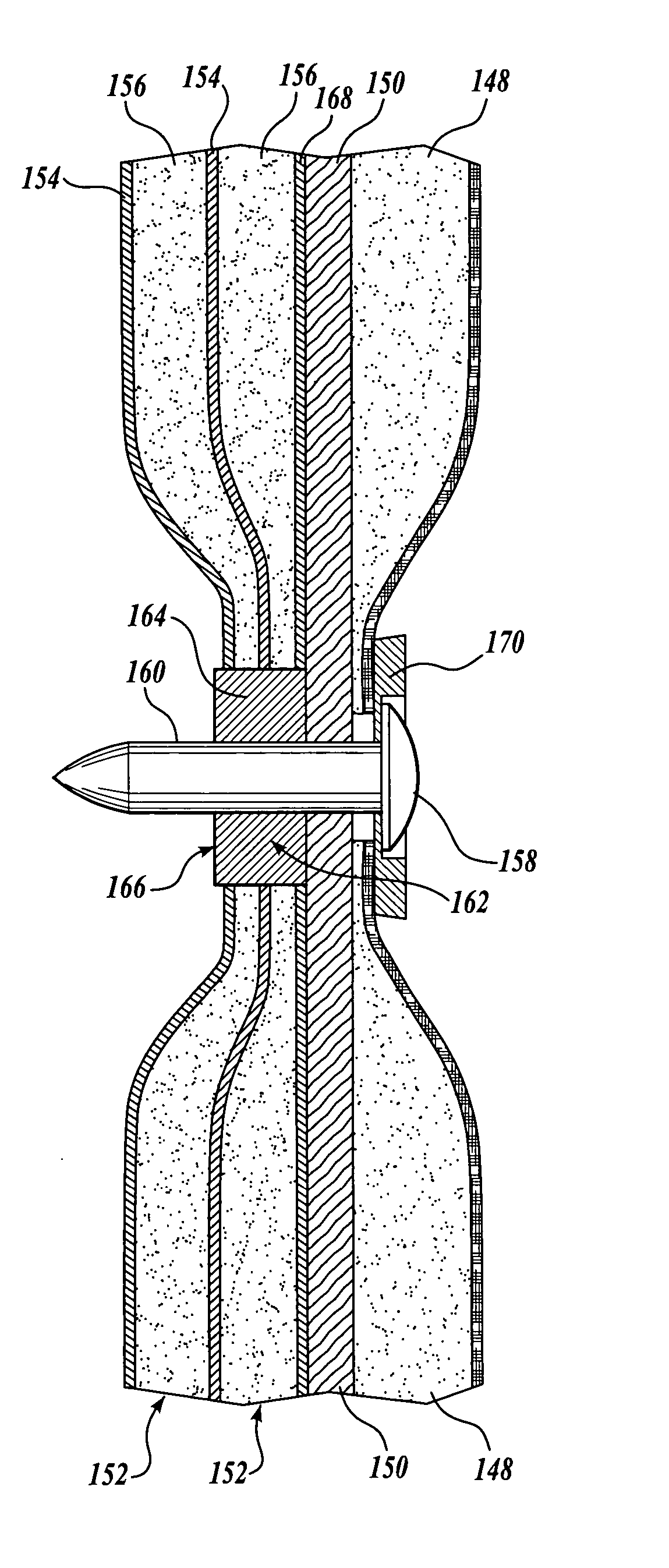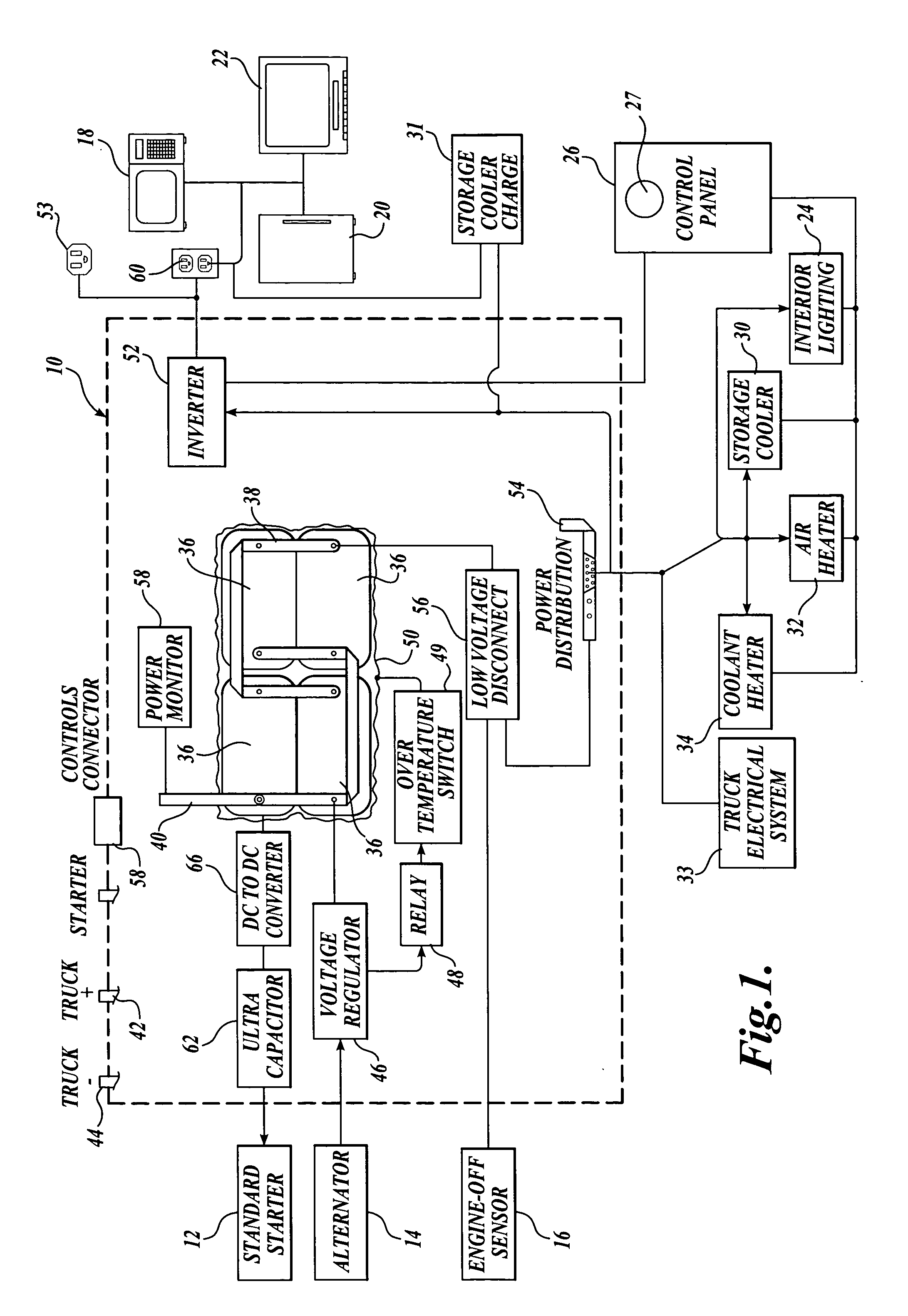[0012] One important aspect of the invention is maintaining the batteries that power the vehicle hotel loads in a controlled thermal environment to ensure battery operation at or near maximum
power capacity regardless of ambient temperature. In accordance with this aspect of the invention, the batteries are contained in a thermally insulated
enclosure and are heated to a predetermined temperature by electrical heating elements when the vehicle engine is in operation. During periods in which the vehicle engine is not running and battery power is being made available for hotel loads, the insulated enclosure maintains the temperature of the batteries high enough to prevent a significant decrease in battery
power capacity even when the ambient temperature is well below freezing. In the disclosed exemplary embodiments of the invention, the battery heaters are connected to the vehicle power system by means of a
relay that is energized and de-energized to control battery temperature. A
voltage regulator includes an arrangement for determining battery temperature based upon a
signal supplied by a temperature sensor that is mounted to one of the battery posts and energizes and de-energizes the
relay so that the batteries are maintained at or near the desired predetermined temperature (e.g., 85° F.; approximately 29° C. in the currently preferred embodiments of the invention).
[0013] The preferred embodiments of the invention do not use the vehicle batteries to start the vehicle engine, using instead a large capacitor that is often referred to as an “ultra-capacitor.” In the currently preferred embodiments of the invention, the fully charged
terminal voltage of the ultra-capacitor is established by an up / down dc-to-
dc converter that is electrically connected between the vehicle batteries and the ultra-capacitor. In these embodiments, the fully charged
terminal voltage of ultra-capacitor is a predetermined voltage (a design value) that is less than the maximum output voltage of the vehicle
alternator and is greater than a voltage that indicates the batteries are in a discharged state. When the
alternator voltage is above the predetermined fully charged ultra-
capacitor voltage, the dc-to-
dc converter down converts the
alternator voltage to the predetermined fully charged ultra-
capacitor voltage. On the other hand, when the system is supplying current to hotel loads and the
battery voltage falls below the voltage that indicates a discharged state, the dc-to-dc converter up converts the
battery voltage to maintain the capacitor charging voltage equal to the predetermined value. Further, in the most preferred embodiments, the dc-to-dc converter includes circuitry for monitoring the
dc current being supplied to the ultra-capacitor. When the charging current falls to a level that indicates that the ultra-capacitor is fully charged, the dc-to-dc converter is de-energized and remains off until the
capacitor voltage falls below the predetermined ultra-capacitor charging voltage (which may be caused by capacitor
self discharge or engine start). Also included in the dc-to-dc converter is circuitry for energizing a light-emitting
diode (LED) to indicate the capacitor is fully charged and available for starting the truck. De-energizing the dc-to-dc converter eliminates dc-to-dc converter quiescent current during periods of time in which the ultra-capacitor is fully charged, thereby conserving energy for use in powering the hotel loads.
[0014] Another aspect of the invention relates to packaging of the electrical power system for ease of deployment in a long-haul truck or other vehicle. In particular, the electrical power system can be arranged in a variety of modular configurations that are suitable for installation at the time of vehicle manufacture or as an after market addition to an existing vehicle. In one disclosed arrangement, the batteries and all other components of the electrical power system are mounted within an insulated enclosure even though the operation of the ultra-capacitor and other system components are not adversely affected by ambient temperature. One
advantage of such an arrangement is that the
thermal mass of the ultra-capacitor and other components provides an additional source of
thermal energy to maintain the interior of the insulated enclosure and, hence, the batteries, within a desired temperature range when the vehicle engine is not running and power is being made available for the hotel loads. In another disclosed embodiment, the ultra-capacitor is mounted in an enclosure that is somewhat similar to a conventional battery box that is located near the engine
starter motor. In that particular embodiment, only the system batteries and battery heater are contained in an insulated enclosure with the insulated enclosure and the remaining electrical power system components being configured as a module that can easily be installed in a long-haul truck or other vehicle.
 Login to View More
Login to View More  Login to View More
Login to View More 


